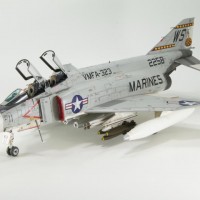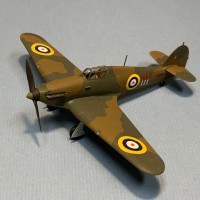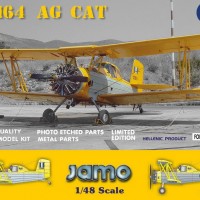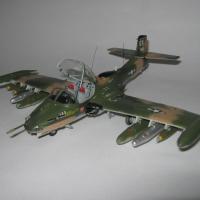Review: Eduard P-51B 2 seat "hack" (conversion)
The Airplane:
Once the P-51D with its bubble canopy providing 360-degree visibility started showing up in VIII Fighter Command units in the summer of 1944, the days of the P-51B were numered, despite most pilots acknowledging the earlier Mustang had better performance since it was nearly 1,000 pounds lighter. Excellent visibility and six guns mouned so they wouldn't jam quickly won the day.
By the fall of 1944, those P-51Bs still around were finally withrawn from operations due to war-weariness. Some were used for conversion training to the Mustang, others were used in a group's “Clobber College” operational training unit.
In early 1945, enterprising ground crews took P-51Bs and Cs in better shape and turned them into two-seat “hacks.” Gun were removed and the gun bays turned into baggage compartments. The fuselage fuel tank and radio gear behind the pilot were taken out, and the area of the fuselage at the rear of the cockpit was modified or removed, with a seat crammed in for a passenger. None of these were dual-control aircraft, since there was no space in back for rudder pedals and control sticks without placing things too far aft to remain in balance. Either a “coffin lid” canopy or a Malcolm hood was used over the rear seat.
The Fourth Fighter Group's maintenance unit rebuilt four two-seaters - one for each of the three squadrons and one for group headquarters. They were used for transportation to meetings and such, and to provide the long-serving ground crews with the opportunity to experience flight in a Mustang. None survived the end of the war.
The Kit:
Eduard's release of a P-51B/C with dorsal fin marks only the second time a Mustang in this configuration as been released, the first being the Accurate Miniatures P-51B/C from nearly 30 years ago.
The kit maintains Eduard's design philosophy of creating a separate fuselage for the sub-type, rather than using inserts as Hasegawa has done. There are two separate Overtrees kits - one with the clear plastic for the Malcolm hood and one with the clear plastic for the “coffin lid” canopy. Interestingly enough, the fuselage does not have the internal mounts to insure correct placement of the exhausts or the disk at the front end of the fuselage. Modelers will have to insure proper fit on their own.
The nice thing about these Overtrees releases is that a modeler can finally do most of the postwar Bendix Trophy and Thompson Trophy P-51B racers, since they all eventually had the dorsal fin.
Construction.
This is an easy conversion. I “eyeballed” this project using several photos of the WD-2 conversion.
I first modified the wing by filling in the ammunition chutes in the lower wing, then plugging the gunports with Evergreen dowel once assembled.
Fortunately, I had two “coffin lid” sprues left over from previous projects. I measured the area to cut out of the rear fuselage and did so with a razor saw.
When I assembled the cockpit, I left out the fuel tank and the associated battery and radio gear. I made backing pieces for each seat from Evergreen sheet, and used the seat for the P-51B-1 option. In this case, I had two 3D seats with molded-in straps that were sent for review and used them. They are both much easier than the original plastic seats as regards assembly. Whether they are worth the additional price is up to the individual modeler.
Photos showed a fairing installed immediately behind the rear canopy. I used Evergreen .010 sheet, cut to shape, then sanded down the rear edges as thin as possible, then attached the fairing gluing a little bit at a time and bending it to fit properly.
Painting and Markings:
I firt pinted the red nose, then masked it. I painted the lacquered wings with Tamiya “Gloss Aluminum” LP-70 and painted the rest of the model with Mr Color Super Metallics “Duraluminum” SM-208.
I purchased the Draw Decals sheet, and discovered the markings are for a warbird conversion, and not really accurate for the original airplane. I ended up using only the red-white-blue rudder decals from that sheet, and the serial number - corrected to 312193 instead of 12193. I used letter and number decals from Squadron Decals 45-degree Black Lettering sheet, SQD 48019a for the fuselage codes and the missing “3" in the serial. Fortunately, all the stenciling was removed from this airplane.
A modeler with access to making their own decals could do the later overall-red scheme with light blue insignia and lettering. I opted for the airplane as first finished.
Final Assembly:
I attached the landing gear, the canopies, the propeller and the exhausts.
Overall:
I've always wanted to do one of these “hacks.” I might even do “VF-4, which was overall medium blue with a Malcolm canopy over the rear seat. There's a lot of opportunity with this kit from Eduard to do some interesting early Mustangs.














That turned out great, Tom. A real standout amongst Mustangs.
Excellent result, Tom!
A different Mustang, perfectly done!
Your conversion is a total success. You made it seem E-Z-P-Z. Nice to see a unique Mustang variant, Tom.
Very nice work on this conversion, Tom @tcinla
Well done.
A very nice conversion - the fairing came out very well.
Nicely done, Tom. The "hack" job looks good.
Well done unique scheme. Two seater Mustangs are rare enough.
Very nice! Excellent rendition of a subject you rarely see.
Well done conversion!
That would have been a treat to be in back of a P-51.
Knowing Tom Cruise is one way to get a ride nowadays - prob not gonna happen.
Excellent work on this 'hack'.
Excellent conversion! Have you ever done a two seat P-40?
Thinking about doing so, now that the Hasegawa P-40N kit is about to become "surplus to requirements."
Great conversion, Tom (@tcinla). The NMF came out perfectly.
G’day Tom (@tcinla),
This is a great conversion and you have given me an idea for one of my own.
Liked!
@tcinla - Nice work Tom. Always cool to customize!